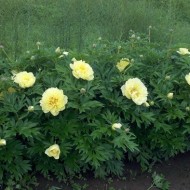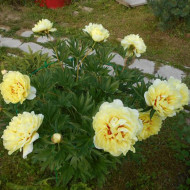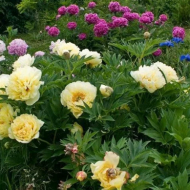Growing and using in garden design of the spectacular peony Bartzell
Content
Peony Bartzell's story
Peonies are one of the favorite flowers in China, consonant with its ancient history. Locals idolize them, using them as decoration and preparing medicines. The Chinese believe that culture has mystical properties, protecting from dark forces.
Most peony varieties are white or pink. The task of getting the yellow flower was set by the Japanese grower Toichi Itoh in 1948. The beginner's progenitors were:
- Japanese tree variety Kinko (paternal line);
- semi-shrub hybrid Kakoden (maternal origin).
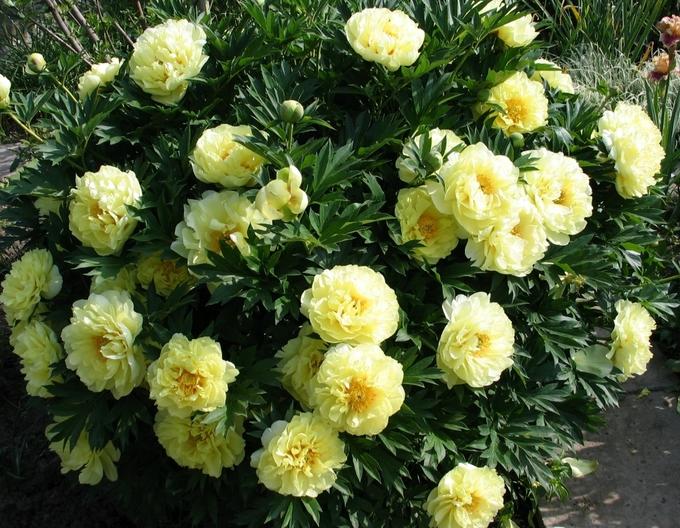
As a result, 6 heirs were bred, until the flowering of which their creator did not live. After the death of the scientist, his students continued his work. As a result, more than 1,000 different modifications were obtained. The current result was presented to the general public in 1974. The novelty was named the peony Itoh Bartzella - the first part of the name is in honor of the creator, the second is a sign of respect for the pastor of the breeder's family (derived from the surname Bart).
World recognition for the flower came in 2002 after receiving the Grand Prix at the International Exhibition.
Description of ITO-hybrid Bartzell
Here is a botanical description of the flower:
- The bush is round, tree-like shoots, densely covered with large dark green carved leaves. Stems grow up to 1 m. With the onset of cold weather, the foliage falls off, the woody part remains.
- The flowers are yellow, the central part is orange. Massive (buds about 25 cm in diameter), fringed.
- Flowering occurs at the beginning of summer, lasts a month. Flowers emit a light, pleasant aroma.
- On average, an adult bush holds up to 60 buds, young bushes - less.
- Withstands frosts down to -30 ° С. Frozen areas are restored with the arrival of heat.
- Unpretentious, resistant to viral ailments. Drought tolerant. In the season of active growth and during the formation of buds, it needs abundant watering.
- When cut, the bouquet does not lose its appearance for about 2 weeks.

The hybrid takes root well throughout our country. In the Moscow region, it easily tolerates winter cold, and in the southern regions it grows for 10 or more years. ITO-Bartzell peonies are elite varieties, and therefore planting material is expensive.
Video "Growing Peony Bartzell"
In this video, experts share the secrets of planting and caring for horticultural crops.
The subtleties of planting a peony Bartzell
If you follow all the rules of agricultural technology, the planted crop will be able to grow comfortably in the chosen place. Let's analyze the nuances of planting seedlings of a young plant.
Selection of soil and site
There must be a lot of sun and warmth in the selected area.Some midday shade will not hurt, the petals will fade less in the sun. After precipitation, water should not stagnate in this place - flowers do not like waterlogging. It is better that perennial flowers that can take up nutrients do not grow nearby.
The soil is selected light, providing good ventilation for the roots. The land needs fertile, rich in nutrients. Neutral and slightly alkaline soils are considered ideal for crops. If there are none, it is advisable to fertilize the soil by feeding each square meter of future crops with a mixture of humus and manure, adding here:
- one and a half glasses of double superphosphate;
- two glasses of wood ash;
- 150-400 g of dolomite flour (the exact amount is selected based on the degree of acidity of the soil);
- 2 cups bone meal.
Seedling preparation
The purchased seedling is disinfected before planting. To do this, the roots are soaked for half an hour in a solution of potassium permanganate.
It is a good idea to soak the seed in a solution of biostimulants such as Epin-extra or Zircon. They promote more active growth, while at the same time strengthening the immune system.
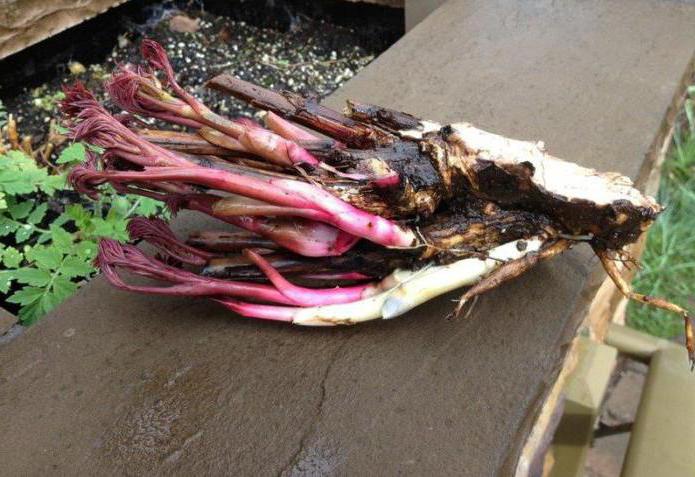
Timing and planting process
It is advisable to plant peonies in late August or September. For regions with a mild climate, the dates are extended until the end of October.
The planting process is as follows:
- The organic mixture prepared in advance is mixed with the garden soil at the selected place. More sand is added to the alumina, making the structure loose. Recommended acidity pH: 6.5-7.5.
- Digging a hole with dimensions of 80:80 or 100: 100 cm. The bottom is drained with fine gravel, expanded clay or brick fragments. Fertile soil is poured over 2/3, they give time to settle a little.
- Moisten the earth, spread the root in the center, with a slight slope, and sprinkle it with earth. It is important that the existing buds go deeper no more than 3-5 cm from the surface.
- The root collar is surrounded by a mixture of sand and ash in equal proportions. This will reduce the risk of root rot.
The plant will begin to bloom in 2-3 years. The first buds do not look beautiful - the shape is irregular, the petals are crooked. But after another year, their appearance is normalized.
Features of care for ITO hybrids
It is no more difficult to care for an elite culture than for classic grassy pythons. The variety is not afraid of ailments and normally tolerates a dry period, if you follow agrotechnical standards.
Watering and feeding rules
The hybrid is hygrophilous, therefore the plant needs to be watered regularly and abundantly. When finished, check if moisture accumulates in one place. The amount of water depends on the weather. In summer, on hot days, count on 2-3 buckets per bush. In cloudy weather, watering is significantly reduced. It is carried out only after the upper root circle dries up, usually this happens on the 7th day.
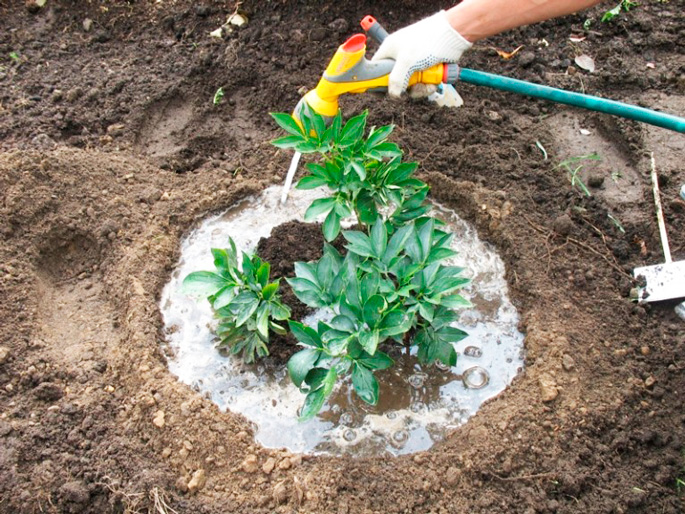
The culture needs feeding twice a season:
- nitrogen fertilizers are applied before the beginning of the growing season;
- potassium superphosphates upon completion.
Young bushes feed on the leaf, since the roots are not yet developed. Top dressing is highly diluted so as not to burn the foliage.
Loosening and mulching
After heavy watering or after heavy rain, the soil should be loosened, providing air access. Mulching is not necessary; this procedure is performed in preparation for wintering.
Transplant and reproduction
Once a year, after flowering, the peonies are sanitized pruning. This involves removing dried flowers and shoots and collecting fallen leaves and flowers.
For propagation of the bush, it is better to use the method of dividing the rhizome. This procedure is performed with a plant from 3 years old and older. We'll have to tinker with the lower part - in Bartzell's peony, it is tree-like, solid. You may need to saw.Gardeners with sufficient experience need to deal with division, since wrong actions can ruin the culture.

The procedure is performed at the beginning of autumn, if later, the plant should be treated with a biostimulant. It is carried out in several stages:
- Water the root soil, then dig out the entire root. Do not be afraid to damage the roots - they are strong.
- They shake off a clod of earth, cut the bush into 2-3 parts, leaving several buds on each.
- The cut points are sprinkled with charcoal, then the fragments are placed in a dark place, giving the charcoal time to dry.
- They are planted in new places according to the rules.
Another method of propagation - cuttings - is rarely used, since the procedure requires a lot of experience.
Treatment against diseases and pests
The variety is not susceptible to the invasion of insects, immune to most ailments. With proper observance of the norms of agricultural technology, such protection measures are enough:
- treatment of seedlings with a fungicide from decay;
- the use of biostimulants to strengthen the immune system.
Wintering plants
By the beginning of October, the bush is covered with a layer of peat, compost or hay; more serious protection is not required. When the snow melts in the spring, the mulch is scattered, allowing the buds to grow again.
The use of Bartzell's peony in garden design
Ito-peonies in landscape design look beautiful alone (tapeworms) and in a group. Any design fit options are suitable:
- separate flower beds - a green lawn and a single bush in the middle;
- framing steps and benches;
- decoration of garden paths or the perimeter of the site in the manner of a hedge;
- decoration of mixborders, alpine slides, etc.
For group planting, bright yellow buds should be diluted with white or red varieties.
- Low hedge
- Garden path decoration
- Composite fit
- Flower bed
- Flower garden
- Flowerbed of peonies
Gardeners reviews
“I read the reviews and risked spending a considerable amount on the purchase. Surprised by the flowering - large hats began to appear en masse already in the second year. Now she planted them not only throughout the country house, but also decorated the adjacent territory at the entrance. They grow excellently. "
“I chose the variety because it is unpretentious - there is no time to be at the dacha often. They grow superbly, they don't need me at all. There is no need to dig up and replant - they will stand for 10 years in one place. "
The ITO-Bartzella peony variety is picturesque, looks spectacular in a garden or on a city flower bed. The culture does not need special care; even a novice amateur can grow a bush. Every self-respecting summer resident should have at least one bush of this unusual variety in the garden.

